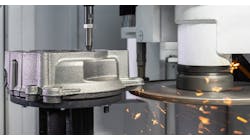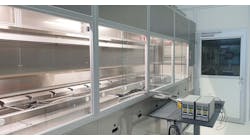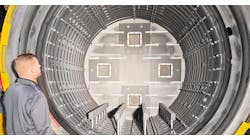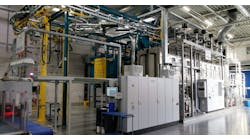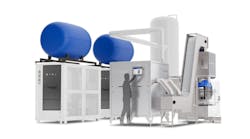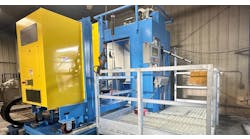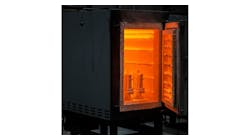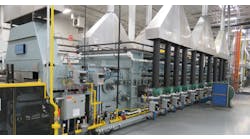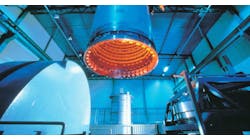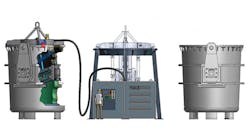Maintaining large casting ladles is not a project that inspires the high-tech visions of design engineers, nor even the plant operations managers who recognize the importance of such tasks. A new vertical milling machine proposed by a hydraulic system developer may alter some perspectives on that mostly tedious task. According to Simpex Hydraulik, its MLC 2011 unit will simplify ladle maintenance, and reduce refractory and waste-disposal cost.
The MLC 2011 mobile vertical ladle milling unit contains a precisely controllable milling head for removing fused refractory material and baked-on slag from monolithic linings of ladle interiors, leaving the vessel in optimal condition for applying a new layer of refractory.
Before a ladle can be relined, the inside wall must be fully cleaned of the fused material and slag, in order for new refractory concrete to properly bond with the remaining refractory layer. It’s also important that still-functional refractory material is undisturbed.
The MLC 2011 ladle milling unit operates with a precisely controllable milling head. The thickness of the layer to be removed is set according to the degree of fusion. So, while cleaning ladles with manually operated machinery or hydraulic hammers is a very difficult process to control, the new machine removes the worn refractory layer in a way that Simpex described as “perfectly controlled and uniform.”
The system consists of the milling equipment, a holding frame, and a container that holds the hydraulic unit, including the tank and the controls.
To operate, a crane is used to lift and place the milling unit into the ladle. Three hydraulic cylinders ensure that the unit is perfectly centered and fixed inside the ladle. In this way, the milling head is always positioned accurately relative to the ladle, and it can be moved to any position of the lining, automatically or manually by remote control.
Milling is performed automatically and takes approximately one hour to complete. Afterward, the milling unit will be replaced in the holding frame, or into the next ladle to be milled.
The entire process is conducted automatically, which reduces significantly the time required for ladle cleaning, compared to the alternative processes. Depending on the ladle size, the MLC 2011 operation can be completed in approximately one hour. When the milling is done, the ladle’s interior walls are visually inspected. If necessary, another layer can be removed or specific areas will be reworked with the milling head operated manually.
The system also is suitable for spot repairs in cases where it is not necessary to mill the complete inside wall of the ladle.
The amount of waste material is reduced because the system removes no more material than I necessary, which will reduce transport and disposal costs, as well as the volume of new refractory concrete required. That material (typically aluminum oxide, AI2O3), may be recycled too, for example as slag forming agents.
According to the developer, using the MLC 2011 ladle milling unit will prolong the service life a ladle’s permanent lining. “As the ladle is in the upright position during milling, it sits solidly in the ladle cone,” according to Simpex. “Therefore it is subjected only to pressure load. Moreover, there are no impact effects acting on the monolithic or the permanent lining, as would occur during manual wrecking with the ladle in a tilted position.” In short, the milling unit reduces the possibility of cracking and brittleness in the ladle lining.
Simpex Hydraulik developed the ladle milling unit in cooperation with Hackenberg Ingenieurgesellschaft. The design phase is complete, and the first prototype — for casting ladles with a volume of 80-160 metric tons — will be ready for testing soon.
